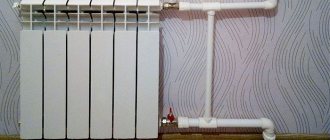How hydraulic calculation calculations are carried out
There are some problems that need to be solved in order to perform a hydraulic calculation of the heating system:
- Determine the diameter of the pipes in all sections of the system (do not forget to take into account the speed of movement of the coolant).
- Calculate the pressure loss.
- Solve hydraulic linkage.
- And, of course, coolant consumption.
What free programs are there for this?
As you might guess, this program is designed to quickly perform the necessary calculations. First, you need to make all the appropriate settings and select the most suitable pieces of equipment. In this way, completely new circuits can be created. Moreover, a ready-made scheme can be adjusted as necessary.
This software harmoniously combines both options, allowing you to create original projects and adjust old ones. The program has the widest capabilities regarding hydraulic calculations, from coolant flow to the selection of pipes of the required diameter. All results of your work can be imported into the operating system in any form.
This program is freely available. It allows you to calculate everything necessary for systems, regardless of the number of pipes. A significant difference between Hertz, which sets it apart from other analogues, is that you can create various projects, both in new buildings and in reconstructed buildings, in which the coolant is a glycol mixture. The program was certified by CSPS LLC.
Data entry is very convenient, as it is done graphically. The results of calculations are visualized in the form of diagrams.
With its help you will calculate the surface or radiator. It consists of a special set of four similar programs. So, let's look at the program's capabilities:
- Selection of pipeline depending on diameter.
- Selection of appropriate radiators.
- It determines the height at which the pumps must be placed.
- Various types of calculations of heating surfaces.
- Determining the most suitable temperature.
Unlike previous options, you can only download a trial version of the program for free, which, of course, has some limitations. First of all, in the vast majority of options you will not be able to not only import the image into the operating system, but even print it. In addition, each individual application has a unique limit: three completed projects per one. At the same time, you can modify it an infinite number of times; this is not prohibited. And finally, finished projects will be saved in a special format; such an extension will not be able to be read by any other version.
As a result, I would like to note that the hydraulic calculation of the heating system is an integral part of the modern control system. In order to select control valves without having an idea of what is happening on the market at the moment, you will have to make calculations over the entire area of the structure, it is advisable to use the richest possible library. The operation of the entire system will depend on how correct your data is.
Example of hydraulic calculation in Excel
Let us immediately note that the simplest hydraulic calculation of the heating system will be described below. An example calculation was performed using theoretical hydraulic formulas for a straight pipeline in a horizontal plane 100 m long. A pipe with an outer diameter of 108 mm and a wall thickness of 4 mm is used.
Hydraulic calculation in Excel.
For calculations we need the following initial data:
- water consumption;
- supply and return temperatures;
- nominal diameter of the pipe;
- contour length;
- pipe roughness;
- overall resistance coefficient.
Using the example of a hydraulic calculation of a heating system, we need to determine three main criteria - these are pressure loss due to friction (PDTr), pressure loss at local resistance (PDMS) and pressure loss in the pipeline (PDTP). All values must be in Pascals (Pa). The formulas presented below will be calculated in kg/cm. sq. To convert kg/cm. kv in Pascals multiplied by 9.18 and 10 thousand.
To calculate PDTr, we need to multiply the hydraulic resistance characteristic by the coolant temperature delta. To calculate PDMS, you need to multiply the average density of water by PDTr, the coefficient of hydraulic friction and by 1 thousand. Then we divide the resulting value by 2, then by 9.18 and by 10 thousand. Pressure losses in the pipeline are calculated by summing PDTr and PDTp.
Calculations and work that need to be done in advance
Hydraulic calculation is the most time-consuming and complex design stage.
- Firstly, the balance of heated rooms and premises is determined.
- Secondly, it is necessary to select the type of heat exchangers or heating devices, and also arrange them on the house plan.
- Thirdly, calculating the heating of a private house assumes that a choice has already been made regarding the configuration of the system, types of pipelines and fittings (control and shut-off).
- Fourthly, a drawing of the heating system must be made. It is best if it is an axonometric diagram. It should indicate numbers, length of calculation sections and thermal loads.
- Fifth, the main circulation ring is installed. This is a closed loop that includes successive sections of pipeline directed to the instrument riser (when considering a single-pipe system) or to the most distant heating device (if there is a two-pipe system) and back to the heat source.
Automated hydraulic calculation of heating system Excel
To make it more convenient to make hydraulic calculations, you can use various computer programs that allow you to perform accurate calculations. Excel is considered one of the most popular programs.
It is also possible to calculate hydraulics using online calculations in CombiMix 1.0. There are even special online calculators that help you perform hydraulic calculations.
By the way, if you do not know the basics of hydraulics, then it will be difficult for you to do this, even in computer programs. This is due to the fact that some of them do not have decoding formulas and calculations of resistance in particularly complex circuits.
Nuances of some programs:
- OvertopCO and DanfossCO can calculate calculations for natural circulation systems;
- HERZ CO 3.5 – works according to the method of calculating specific pressure losses;
- Potok - copes well with calculations based on changing temperature differences along risers.
When entering temperature data, it is necessary to clarify whether the calculation is carried out in Celsius or in Kelvin.
As for working in Excel, using spreadsheets is very convenient. You just need to know the sequence of actions and the exact calculation formulas. First, select the desired cell into which the data is entered. Further calculations occur through automatic application of formulas.
For example, in order to calculate the diameter of pipes, we need to know:
- The difference between hot and cold heat sources for a two-pipe system or fluid flow for a single-pipe system;
- The speed of movement of the heat source and its flow;
- Liquid density and parameters of the studied areas (their length in meters and the number of instruments located there).
To calculate the sizes of pipes within each section, it is convenient to use Excel tables.
HERZ calculation program HERZ official website of HERZ Armaturen in our country
We also inform you that the HERZ valve database in the RAUCAD program has been updated. If you have any questions about obtaining a new database, please contact the engineer of the technical support group of the internal engineering systems department, Moscow, tel. (ext. 203).
HERZ CO program
The HERZ CO program is needed for hydraulic calculations of single- and two-pipe heating systems and cooling, during the design of new systems, as well as for regulating existing ones in reconstructed buildings (for example, after insulating a building), it has the ability to calculate systems where the heat carrier is glycol mixtures.
The program makes it possible to perform all hydraulic calculations of equipment, within the framework of which:
diameters of pipelines are selected; water flow in the designed equipment is analyzed; pressure losses in the equipment are determined; the hydraulic resistance of the circulation rings is determined, taking into account the gravitational pressure associated with cooling of water in pipelines and heat consumers; settings of pressure difference regulators installed in places selected by the designer (base of risers, branches, etc.) are selected; the required authorities of thermostatic valves are taken into account; excess pressure in the circulation rings is reduced by selecting valve presets; The need to equip an appropriate hydraulic resistance in the area with the heat consumer is taken into account.
The program uses many solutions to make work easier and better. The most important of them are:
- graphical data entry process;
- presentation of calculation results on diagrams and floor plans;
- a developed contextual help system that provides information both about individual program commands and a hint regarding the entered data;
- multi-window environment, it allows you to simultaneously view many types of data, results, etc.;
- usual cooperation with printer and plotter, function of previewing pages before printing and outputting to plotter;
- luxurious diagnostics of errors and the function of their automated search, both in the table and in the diagram;
- quick access to catalog data of pipes, radiators and fittings.
HERZ OZC program
The HERZ OZC program is used to determine the estimated heat losses of individual rooms in a building, as well as the entire structure. The calculation is carried out in accordance with the appropriate standards. The program does:
- calculation of heat transfer coefficients for walls, floors, roofs and ceilings between the top floor and the attic;
- calculation of heat loss for individual premises;
- calculation of heat loss of the entire building.
The program uses many solutions to make work easier and better. The most important of them are:
- developed help system;
- luxurious catalog of materials for construction;
- function of automated determination of resistance to heat transfer, resistance of air layers of floors between the top floor and the attic, soil resistance;
- function for automated creation of the next floors, copying of rooms, and also selection of rooms, for example, if while entering data about a room it is necessary to call another room;
- option for automated distribution of heat losses from a room with a small need for heating capacity (for example, a corridor) to adjacent rooms, which provides the opportunity to directly transfer calculation results to the HERZ CO program
The program provides the opportunity to carry out calculations of heat losses of huge buildings.
The following are restrictions regarding the data:
Limit number of defined fences: 16300 Limit number of layers in one fence: 16300 Limit number of rooms: 16300 Limit number of fences in one room: 16300
The results of heat loss calculations are the output data for the HERZ CO program used for designing district heating systems.
Calculation programs for installation on your computer
| HERZ CO version 3.8 setupco.exe (file size 122 MB) more details HERZ OZC version 3.0 setupozc.exe (file size 4 MB) why the HERZ OZC 3.0 program HERZ for MagiCAD database update does not start (file size 768 KB) more details | |
| User's manual for working with the HERZ CO and HERZ OZC programs: Handbuch_HERZ_CO.pdf, Handbuch_HERZ_OZC.pdf | |
| Programs for selecting balancing valves and radiator valves (xls format) | |
The HERZ CO program is intended for the hydraulic calculation of one- and two-pipe heating and cooling systems, when designing new systems, as well as for regulating existing ones in reconstructed buildings (for example, after insulating the building), it has the ability to calculate systems where the coolant is glycol mixtures.
The program provides the opportunity to perform all hydraulic calculations of equipment, within the framework of which:
- pipeline diameters are selected;
- water consumption in the designed equipment is analyzed;
- pressure losses in the equipment are determined;
- the hydraulic resistance of the circulation rings is determined, taking into account the gravitational pressure associated with cooling of water in pipelines and heat consumers;
- settings of pressure difference regulators installed in places chosen by the designer (base of risers, branches, etc.) are selected;
- the required authorities of thermostatic valves are taken into account;
- excess pressure in the circulation rings is reduced by selecting preliminary valve settings;
- the need to ensure appropriate hydraulic resistance of the area with the heat consumer is taken into account.
The program uses many solutions to make work easier and better. The most important of them are:
- graphical data entry process;
- presentation of calculation results on diagrams and floor plans;
- a developed contextual help system that provides information both about individual program commands and a hint regarding the entered data;
- multi-window environment that allows you to simultaneously view many types of data, totals, etc.;
- simple collaboration with a printer and plotter, the function of previewing pages before printing and plotting;
- rich error diagnostics and automatic search function, both in the table and in the diagram;
- quick access to catalog data of pipes, heating devices and fittings.
The HERZ OZC program is used to determine the calculated heat loss of individual rooms in a building, as well as the entire building. The calculation is carried out in accordance with the relevant standards. The program does:
- calculation of heat transfer coefficients for walls, floors, roofs and attic floors;
- calculation of heat losses for individual rooms;
- calculation of heat losses of the entire building.
The program uses many solutions to make work easier and better. The most important of them are:
- developed help system;
- rich catalog of building materials;
- function of automatic determination of heat transfer resistance, resistance of air layers of attic floors, soil resistance;
- the function of automatically creating the next floors, copying rooms, as well as selecting rooms in the event that while entering data about a room it is necessary to call another room;
- option for automatic distribution of heat loss from a room with a low need for heating power (for example, a corridor) to neighboring rooms, which makes it possible to directly transfer the calculation results to the HERZ CO program
The program makes it possible to perform heat loss calculations for very large buildings.
The following are restrictions regarding the data:
Maximum number of defined fences: 16300 Maximum number of layers in one fence: 16300 Maximum number of rooms: 16300 Maximum number of fences in one room: 16300
The results of heat loss calculations are the output data for the HERZ CO program used for designing central heating systems.
3.14zdc
Regarding preliminary work.
Due to the fact that hydraulic calculations require a lot of time and effort, we need to first perform some calculations:
- Determine the balance of premises and rooms that are heated.
- Decide on the type of heating equipment and heat exchanger. Arrange them according to the general plan of the building.
- Before you begin the calculation, you should select the pipelines and decide on the configuration of the heating system as a whole.
- It is necessary to make a drawing of the system, preferably an axonometric diagram. In it, indicate the length of the sections, numbers and load magnitude.
- The circulation ring should also be installed in advance.
Important! If the calculation concerns a wooden house, then there are no differences between it and a brick, concrete, etc.
will not be.
Calculation procedure
Hydraulic calculation of the heating system involves solving the following problems:
- determination of pipeline diameters at various sections (economically feasible and recommended coolant flow rates are taken into account);
- calculation of hydraulic pressure losses in different areas;
- hydraulic linkage of all branches of the system (hydraulic instrumentation and others). It involves the use of control valves, which allows for dynamic balancing under non-stationary hydraulic and thermal operating conditions of the heating system;
- coolant flow and pressure loss calculation.
Hydraulic calculation methods
As we have already said, hydraulic calculations can be done using an online calculator, using a special program, or in an Excel spreadsheet. The first option is suitable even for those who do not understand anything about heating engineering and hydraulics. Naturally, this method can only obtain approximate values, which cannot be used in large and complex projects.
An example of an axonometric diagram.
The software is very expensive and there is no point in buying it at once, but you can make a table in Excel without investment. You can perform the calculation using different formulas:
- theoretical hydraulics;
- SNIP 2.04.02-84.
But the calculation method may also differ: specific pressure loss or resistance characteristics. The latter cannot be used for gravity systems with natural coolant circulation. When installing small two-pipe heating circuits with forced circulation, it is enough to follow a few simple rules. The main lines are made of polypropylene pipes with an outer diameter of 25 mm. Branches to radiators are made of 20 mm pipes. We wrote about how to choose a pump.
What is hydraulic calculation
Hydraulic calculations are done only for large heating circuits.
The operating principle of a water heating system is that coolant circulates through pipes and radiators. This is a liquid (water or) that is heated in a boiler and then driven throughout the circuit by a circulation pump or due to the force of gravity.
The coolant encounters hydraulic resistance during circulation. In addition, the liquid stops a little due to friction against the walls of the pipes. Hydraulic calculation of heating systems is performed in order to calculate the optimal value of the circuit resistance at which the coolant speed will be within normal limits (2-3 m/s for a sealed circuit). At the end of the calculations, we will know the following key parameters:
- for contour;
- circulation pump power;
- number of revolutions to adjust on each radiator.
Regardless of where the hydraulic calculation of the heating system was performed, on an online calculator or in Excel, its benefits are difficult to overestimate. Since we kill two birds with one stone: the circuit works like a clock and there is no cost overrun, because we will know exactly the optimal parameters of the system elements.
Hydraulic calculations need to be done only for large heating systems that heat houses with an area of 200 square meters or more. For small contours this is not necessary.
Specialists make hydraulic calculations of the heating system in an Excel spreadsheet. This is a very complex process, which not all people with specialized education, not to mention amateurs, can do. You need to understand heating engineering, hydraulics, know the basics of installation and much more. This knowledge can only be obtained at a higher educational institution. There are specialized programs for hydraulic calculations of heating systems. But again, only people with specialized education can work with them.










